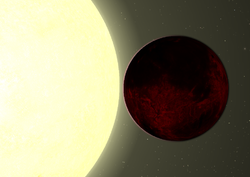 Artist's impression of the planet Kepler-78b around Kepler-78 | |
| Observation data Epoch J2000 Equinox J2000 | |
|---|---|
| Constellation | Cygnus |
| Right ascension | 19 34 58.01374 |
| Declination | +44° 26′ 53.9602″ |
| Apparent magnitude (V) | 11.72 |
| Characteristics | |
| Spectral type | late G |
| Astrometry | |
| Proper motion (μ) | RA: 38.195 mas/yr Dec.: −16.309 mas/yr |
| Parallax (π) | 8.0085 ± 0.0104 mas |
| Distance | 407.3 ± 0.5 ly (124.9 ± 0.2 pc) |
| Details | |
| Mass | 0.779+0.032 −0.046 M☉ |
| Radius | 0.7475+0.0077 −0.0078 R☉ |
| Temperature | 5058±50 K |
| Metallicity | −0.18±0.08 dex |
| Other designations | |
| Kepler-78, KIC 8435766, TYC 3147-188-1, 2MASS J19345800+4426539 | |
| Database references | |
| SIMBAD | data |
| KIC | data |
Kepler-78 (formerly known as KIC 8435766) is a 12th magnitude star 407 light-years (125 parsecs) away in the constellation Cygnus. Initially classified as an eclipsing binary with orbital period 0.710015 days, it was later re-classified as a single star with significant interaction between star magnetosphere and close-in planet. The radius of the star is of about 74% of the Sun, and the effective temperature is about 5100 K. Yıldız çekim kuvveti 523,6758338802 Newton yıldızdan ayrılma hızı738.011,05009176 metre saniye
Planetary system
The Kepler-78 planetary system is composed of one known planet called Kepler-78b, a planet slightly bigger than Earth with an extremely close orbit to the parent star. The orbital period of this planet is about 8.5 hours because of its proximity to its star. While it has a similar density to the Earth (at 5.57 g/cm), its surface temperature is about 1300 to 1500 K.
| Companion (in order from star) |
Mass | Semimajor axis (AU) |
Orbital period (days) |
Eccentricity | Inclination | Radius |
|---|---|---|---|---|---|---|
| b | 1.68±0.27 M🜨 | 0.00901+0.00012 −0.00019 |
0.35500745±0.00000008 | 0 | 75.2+2.6 −2.1° |
1.201±0.028 R🜨 |
References
- ^ Vallenari, A.; et al. (Gaia collaboration) (2023). "Gaia Data Release 3. Summary of the content and survey properties". Astronomy and Astrophysics. 674: A1. arXiv:2208.00211. Bibcode:2023A&A...674A...1G. doi:10.1051/0004-6361/202243940. S2CID 244398875. Gaia DR3 record for this source at VizieR.
- ^ "Kepler-78". SIMBAD. Centre de données astronomiques de Strasbourg.
- Sanchis-Ojeda, Roberto; et al. (2013). "Transits and Occultations of an Earth-sized Planet in an 8.5 hr Orbit". The Astrophysical Journal. 774 (1). 54. arXiv:1305.4180. Bibcode:2013ApJ...774...54S. doi:10.1088/0004-637X/774/1/54. S2CID 15473397.
- ^ Bonomo, A. S.; Dumusque, X.; et al. (April 2023). "Cold Jupiters and improved masses in 38 Kepler and K2 small-planet systems from 3661 high-precision HARPS-N radial velocities. No excess of cold Jupiters in small-planet systems". Astronomy & Astrophysics. arXiv:2304.05773. doi:10.1051/0004-6361/202346211. S2CID 261556620.
- KEPLER ECLIPSING BINARY STARS. II. 2165 ECLIPSING BINARIES IN THE SECOND DATA RELEASE
- Strugarek, A.; Brun, A. S.; Donati, J.-F.; Moutou, C.; Réville, V. (2019), "Chasing Star–Planet Magnetic Interactions: The Case of Kepler-78", The Astrophysical Journal, 881 (2): 136, arXiv:1907.01020, Bibcode:2019ApJ...881..136S, doi:10.3847/1538-4357/ab2ed5, S2CID 195776491
- Pepe, Francesco; Cameron, Andrew Collier; Latham, David W.; Molinari, Emilio; Udry, Stéphane; Bonomo, Aldo S.; Buchhave, Lars A.; Charbonneau, David; Cosentino, Rosario; Dressing, Courtney D.; Dumusque, Xavier; Figueira, Pedro; Fiorenzano, Aldo F. M.; Gettel, Sara; Harutyunyan, Avet; Haywood, Raphaëlle D.; Horne, Keith; Lopez-Morales, Mercedes; Lovis, Christophe; Malavolta, Luca; Mayor, Michel; Micela, Giusi; Motalebi, Fatemeh; Nascimbeni, Valerio; Phillips, David; Piotto, Giampaolo; Pollacco, Don; Queloz, Didier; Rice, Ken; et al. (2013). "An Earth-sized planet with an Earth-like density". Nature. 503 (7476): 377–80. arXiv:1310.7987. Bibcode:2013Natur.503..377P. doi:10.1038/nature12768. PMID 24172902. S2CID 4397568.